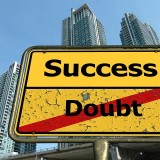Regular contributor Kathie Kelly chatted to Leaders in Heels about her career change journey. If you have a story you would like to share contact us here.
I have loved working with Leaders In Heels since 2012 and have contributed many career articles aimed at helping readers navigate new employment and to have the best chance at changing careers. When I first started writing for Leaders in Heels, I was heading up a recruitment division for a very well-known training organisation. However, in 2013, my circumstances required a change of lifestyle. I had lived with chronic back pain for many years and working 9 to 5 full-time meant a weekend of recovery and not much else. That was fine, but then when my mum got sick due to bowel cancer, I knew something had to give. So out of necessity to care for Mum (and myself), Square Pegs was born.
The first year was pretty all over the place. Not much direction and a lot of me doing whatever work came along that suited my skill set
The first year was pretty all over the place. Not much direction and a lot of me doing whatever work came along that suited my skill set (recruitment/resume writing/tender or grant writing, fundraising assistance), while sitting by hospital beds or taking mum to chemo. Devastatingly, Mum passed away at the end of that first year and, even though it was kind of expected, I was pretty shaken. I took a few months to tidy up all her affairs and then I was left wondering what was next. So back to full-time work I went. However, my body had gotten used to not having to sit in an office chair for fifty hours a week and consequently threw a tantrum. The chronic back pain had not only returned, it was literally taking over my life.
So a new plan was needed. Square Pegs was dusted off again and this time I decided and embarked upon a firm direction. I sat down and thought about what I loved doing, what I was good at, and how I could earn a living. The standout by a mile was finding funding for great causes. Over the last few months I have been steadily building relationships with a variety of clients and loving the opportunity to help both charities and not-for-profit organisations develop new opportunities with funders, corporate partners and sponsors. I have made mistakes, have freaked out that no one would use me, have fist pumped and literally leapt for joy. Yes, it’s been a roller coaster ride as the cliché goes and I’m so lucky to have the fantastic support of my hubby, who has not only supported me financially and emotionally, but also actually believes that I’m pretty good at this stuff (as luckily do a couple of other people too!).
So my advice would be to make lemon out of lemonades. Or vodka out of potatoes.
So my advice would be to make lemon out of lemonades. Or vodka out of potatoes. Basically, rather than being the victim of your circumstances, make the bumps in the road into spring cushions and leap into your passion. If it spins your wheels then chances are your enthusiasm will translate into your work and that makes all the difference.
Featured Photo Credit: Pixabay
Kathie Kelly is the Director of Square Pegs Consulting, and can help charities and not-for-profit organisations with sourcing funding through grants or campaigns and developing corporate partnerships or sponsorships.
Kathie has held senior roles in both corporate and community organisations and as a result understands the motivators and drivers underpinning long-term growth strategies in both sectors. An ex ballet dancer and a keen supporter of the arts, Kathie has also been on the board of the Anywhere Theatre Festival, loves to travel and is an avid rugby league follower. You can connect with Kathie on LinkedIn at http://au.linkedin.com/in/kathiekelly or follow her on Twitter @1KathieKelly.







